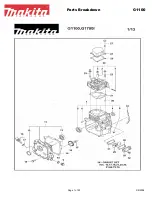
©
2006 Magnum Energy Inc
.
Wiring Guidelines
• Before connecting any wires, determine all wire routes throughout
the home or vehicle/boat both to and from the inverter.
• Conductors passing through walls, bulkheads or other structural
members must be protected to minimize insulation damage such as
chafing, which can be caused by vibration or constant rubbing.
• Always check for existing electrical, plumbing or other areas of
potential damage prior to making cuts in structural surfaces, bulk-
heads or walls.
• Make sure all wires have a smooth bend radius and do not become
kinked.
• Both AC and DC overcurrent protection must be provided as part
of the installation.
• Do not attempt to use a vehicle metal frame in place of the DC
negative connection or DC ground. The inverter requires a reliable
negative and ground return path directly to the battery.
• DC wires and cables should be tied together with wire ties or
electrical tape approximately every 6 inches. This helps improves the
surge capability and reduces the effects of inductance, which im-
proves the inverter waveform and reduces the wear of the inverter’s
filter capacitors.
• Use only copper wires with a minimum temperature rating of 75° C.
• To ensure the maximum performance from the inverter, all connec-
tions from the battery bank to the inverter should be minimized, the
exception is the DC overcurrent disconnect in the positive line and a
shunt in the negative line. Any other additional connection will
contribute to additional voltage drops and these extra connections
points may loosen during use.
• All wiring to the battery terminals should be checked periodically
(once a month) for proper tightness. The torque requirement for the
DC terminals is between 10 to 12 foot-pounds. If you don’t have a
torque wrench, ensure all DC terminals are tight and cannot move.
DC Wiring
This section describes the inverter’s required DC wire sizes and the
recommended disconnect/overcurrent protection and how to make the
DC connections to the inverter and the battery bank.
DC Wire Sizing and Overcurrent Protection
It is important to use the correct DC wire to achieve maximum
efficiency from the system and reduce fire hazards associated with
overheating. See Table 1 to select the minimum DC wire size needed
based on your inverter model. If the distance from the inverter to the
battery bank is greater than 3 feet, use Table 2 to help determine the
minimum recommended cable sizes for longer distances. Always keep
your wire runs as short as practical to help prevent low voltage
shutdowns and keep the DC breaker from nuisance tripping (or open
fuses) because of increased current draw. Undersized cables can also
lower the inverter’s peak output voltage as well as reduce its ability to
surge heavy loads.
• Be aware that overtightening and misthreading the nuts on the DC
terminals can cause the bolts to strip and snap/break off.
2.0 Installation
11
http://www.wholesalesolar.com/inverters.html
http://www.wholesalesolar.com/inverters.html
















































